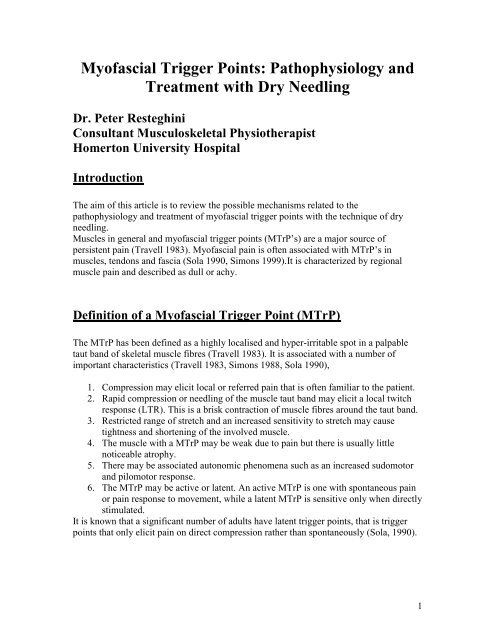
- Travell and simons trigger pain point patterns professional#
- Travell and simons trigger pain point patterns series#
- Travell and simons trigger pain point patterns free#
In 2003, James Bagg wrote this, pertaining to Dr.
Travell and simons trigger pain point patterns free#
“Senator Kennedy received so much relief of pain from my mother’s medical treatments that he had ‘new hope for a life free from crutches if not from backache’.” His improvement was so impressive that Dr. Travell treated Senator Kennedy’s trigger points. Things were so bad that Senator Kennedy was “questioning his ability to continue his political career.”(10) Dr. He had suffered from 2 devastating spinal surgeries, yet he continued to suffer from debilitating back spasm and left leg pain. Travell first saw Senator Kennedy in May of 1955, he was non-ambulatory. Travell treated Senator Kennedy’s trigger points and addressed a number of mechanical issues that perpetuated these trigger points (discussed below). Travell to look at his patient’s chronic, disabling back problems (5). With her growing positive reputation and expertise, Senator John F. Travell’s clinical interest and practice had moved away from cardiology and she became a specialist in musculoskeletal pain syndromes. “Symptoms of angina in the absence of demonstrable cardiac disease should be considered as likely due to TrPs.”īy 1952, Dr. “The pain patterns of the pectoralis major and pectoralis minor muscles mimic the pain referral patterns of cardiac ischemia.”

For several reasons, it appears likely that many such unexpected influences, to and from TrPs, depend on modulation of the autonomic nervous system, in addition to modulation of the sensory nervous system (referred pain).” On several occasions, I saw the conversion of atrial fibrillation to normal rhythm when vapocoolant spray was applied over the arrhythmia TrP on the lower-right anterior chest wall the same effect could be achieved by trigger point pressure release applied to that TrP. Trigger point therapy “could suppress cardiac arrhythmias. Travell’s colleague and co-author of their books, David Simons, MD, Myofascial pain and dysfunction, the trigger point manual, commented: Her successful outcomes led her to believe that she was treating more than somatic pain she believed that she was also influencing aspects of the cardiac pain itself: “in patients suffering from the pain of myocardial infarction convinced her and her colleagues that the treatment could stop both non-cardiac pain of muscle origin and true cardiac pain of coronary insufficiency.”(9) This understanding is important because if true, it would mean that trigger point therapy was influencing aspects of the sympathetic nervous system.
Travell and simons trigger pain point patterns series#
Travell and colleagues reported a series of clinical outcomes following trigger point treatment in cardiac patients (6, 7, 8). Her interest in musculoskeletal pain came about as a consequence of the neck, trunk, shoulder, and arm pains her cardiac patients suffered (5).
Travell and simons trigger pain point patterns professional#
In the first three decades of her professional career she practiced cardiology while teaching pharmacology at Cornell. Interestingly, she was the first female to graduate from Cornell.

In 1926, she received her MD degree from the Cornell University Medical College in New York City, where she graduated at the head of her class. Janet Travell was born in New York in 1901, the daughter of a physician. Travell was the first female physician to hold this prestigious office (2, 3, 4).ĭr. Travell to be his personal White House Physician. When Kennedy was elected president of the United States (taking office in 1961), he chose Dr. The following year, Kennedy came under the care of myofascial pain expert Janet Travell, MD. He nearly died, and his recovery took 8 months. In 1954, Kennedy underwent an attempted spinal fusion operation, and it went badly it was his second spinal surgery for his persistent low back pain. Kennedy’s back problems never fully recovered. Injured (he was awarded the Purple Heart for the event) Kennedy twice swam for miles in the Pacific Ocean, towing an injured crewmember with a life jacket strap in his teeth. His back problems significantly worsened by his legendary heroism in August of 1943 during the sinking of his boat PT-109 in the Pacific during WWII. Kennedy suffered from a notorious bad back. She has been referred to as “the mother of myofascial trigger point knowledge”(1). Travell was an early pioneer in understanding the science, pathophysiology, and treatment of myofascial problems.


Her notoriety is attributed primarily to two events: Janet Travell, MD, is one of the most recognized physicians of modern history.


 0 kommentar(er)
0 kommentar(er)
